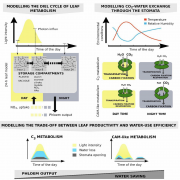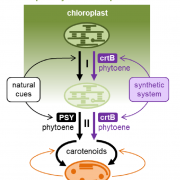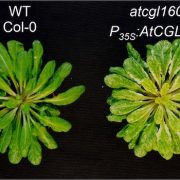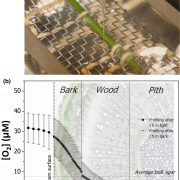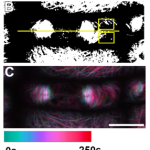Roots are the ‘kitchen’ for leafless epiphytic orchids
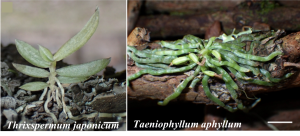 Photosynthesis is the major process which supports plant survival. It’s the kitchen serving food (sugars) to the plant by converting the light energy. Leaves are the major site of photosynthesis for most plants. However, certain plants evolved unconventional ways of performing photosynthesis. In a recent study, Suetsugu et al. discovered an epiphytic orchid (Taeniophyllum aphyllum) photosynthesising via its roots. Compared to its co-occurring leafy counterpart, Thrixspermum japonicum, pigment content in T. aphyllum roots was double, similar to that in T. japonicum leaves. T. japonicum roots also performed photosynthesis, but the electron transport rate and photosynthetic efficiency were much lower than T. japonicum leaves or T. aphyllum roots, suggesting a subsidiary role. The high nocturnal carbon fixation by T. aphyllum roots and T. japonicum leaves indicated an efficient crassulacean acid metabolism (CAM) cycle compared to the C3 cycle in T. japonicum roots. Unlike the C3 cycle, CAM photosynthesis involves temporal separation of photosynthesis and carbon dioxide (CO2) fixation to reduce water loss. The higher number of pneumathodes (aeration cells) in roots probably functioned as stomata in the leaves for CO2 uptake, malate accumulation and nocturnal CO2 fixation. The chloroplast ultrastructure was also similar in roots and leaves, suggesting that morphological sophistication in roots allowed them to act as photosynthetic organ. Further research on the evolutionary role which transferred CAM photosynthesis from leaves to roots, allowing leafless adaptation, will be fascinating. (Summary by Rajarshi Sanyal @rajarshi_sanyal) New Phytol. 10.1111/nph.18812
Photosynthesis is the major process which supports plant survival. It’s the kitchen serving food (sugars) to the plant by converting the light energy. Leaves are the major site of photosynthesis for most plants. However, certain plants evolved unconventional ways of performing photosynthesis. In a recent study, Suetsugu et al. discovered an epiphytic orchid (Taeniophyllum aphyllum) photosynthesising via its roots. Compared to its co-occurring leafy counterpart, Thrixspermum japonicum, pigment content in T. aphyllum roots was double, similar to that in T. japonicum leaves. T. japonicum roots also performed photosynthesis, but the electron transport rate and photosynthetic efficiency were much lower than T. japonicum leaves or T. aphyllum roots, suggesting a subsidiary role. The high nocturnal carbon fixation by T. aphyllum roots and T. japonicum leaves indicated an efficient crassulacean acid metabolism (CAM) cycle compared to the C3 cycle in T. japonicum roots. Unlike the C3 cycle, CAM photosynthesis involves temporal separation of photosynthesis and carbon dioxide (CO2) fixation to reduce water loss. The higher number of pneumathodes (aeration cells) in roots probably functioned as stomata in the leaves for CO2 uptake, malate accumulation and nocturnal CO2 fixation. The chloroplast ultrastructure was also similar in roots and leaves, suggesting that morphological sophistication in roots allowed them to act as photosynthetic organ. Further research on the evolutionary role which transferred CAM photosynthesis from leaves to roots, allowing leafless adaptation, will be fascinating. (Summary by Rajarshi Sanyal @rajarshi_sanyal) New Phytol. 10.1111/nph.18812


